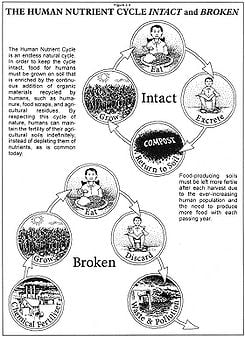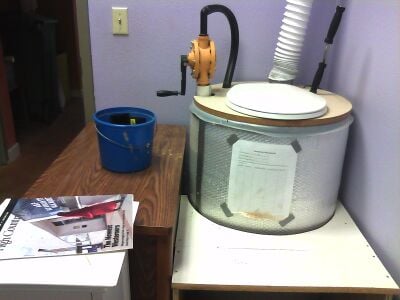
Composting toilets allow human waste to be turned into nutrient-rich compost, which can be used in and around your garden. Using a balance between oxygen, moisture, heat and aerobic bacteria, they create a product from human waste that is essentially the same as your own garden compost [verification needed]. The containers are well ventilated to prevent unpleasant smell and to provide air flow to the aerobic bacteria, which is necessary to break down the organic matter and to remove of any pathogens in the human waste. The end product will then not contain any viruses or pathogens and can be used on plants and trees as a part the natural cycle. This is a cost efficient way to get rid of our waste product while sparing the environment from pollution.
Reasons[edit | edit source]
Every time we flush a toilet, we launch five to six gallons of polluted water out into the world,[1] often without knowing or caring where the polluted water ends up. We now have evidence that the discharge of sludge, wastewater and sewage into nature's waterways are causing pollution which can cause human illnesses. According to the The Humanure Handbook in 2000 55% of the US lakes, rivers and estuaries were not clean enough for fishing or swimming according to the EPA. This was due mostly to sewage run off and contamination. By adding a composting toilet to your facility you can prevent sewage run off and help prevent your waste from polluting our waterways. Also you will create an intact system Human nutrient cycle which allows your waste to be put back into the natural system without harsh pathogens. (the Human Nutrient Cycle Picture right here from the Humanure Handbook Book).
- 5 gal of water per flush X 6 times per avg. human = 9 gal/day X 300,000,000 people in US =2.7x10^9 gal/day of water.
In the United States we use approximately 2.7 billion gallons of water a day just for flushing our waste down the toilet.[2]With a composting toilet you could reduce that amount of water to nothing; no water is needed. By using this type of toilet there is no need for flushing or for the use of water at all. With our water situation looking more and more dire the efficiencies these toilet offer in keeping our water fresh and clean become obvious. 2.7 Billion gallons of water could be saved and used for drinking. Using compost that came from your own feces is a weird thought but it has the same nutrients as your kitchen compost and, in fact, you can't tell the difference. With the aerobic bacteria eating away all the toxins in our waste and a little maintenance the compost could be used instead of chemical fertilizers which will in turn help the environment.[3]
How it works[edit | edit source]
Aerobic decomposition is the key to most composting toilet designs since it is faster, more sanitary, and does not produce the powerful smell, methane, and toxins associated with anaerobic decomposition [verification needed]. Design will vary according to operator needs, but they all address four main aspects which are required for aerobic decomposition:
Aeration By definition, aerobic decomposition can only occur in the presence of oxygen. In order to cultivate adequate oxygen supply a number of techniques are used. Loose, dry material, often in the form of wood shavings, is added which keeps the organic matter from becoming too dense for circulation. Ventilation ducts ensure a steady air exchange and are often designed to maintain slight negative pressure so that odors exit through the exhaust vent rather than into the living space.
Carbon/Nitrogen ratio Human and animal waste is generally much higher in nitrogen content than simple organic matter, and aerobic bacteria perform best and generate more heat if carbon-heavy material like wood shavings or newspaper is added.
Moisture A balance of moisture must be maintained so that the compost material is moist enough for bacteria to thrive, but dry enough to remain loose enough to turn and aerate. In general, human waste will be more than sufficient to provide moisture. Climate and seasonal variation must be taken into account when managing moisture, but in general, dry material should be added such that human waste constitutes not much more than a quarter to a third of the compost by volume.
Size The size of the composting pile will have a direct influence on the temperatures the compost is able to reach without supplemental heating. If a pile is too small, it will radiate its heat more easily and the bacteria will not be able to bring the temperature into a range which will kill pathogens. If a pile is too large, it will be difficult to maintain sufficient aeration. A cubic yard is considered an optimal size for providing both insulation and aeration such that a high, pathogen-killing temperature (140F) [verification needed] can be attained. The size of the material added is also important. Larger, lighter debris is preferable to smaller, more powdery, or denser debris because larger components are less subject to compaction which reduces aeration.
Design[edit | edit source]
All composting toilets manage the above factors either passively or actively. The determining difference among designs is how much operator input and management is required. Some systems use a simple drum fitted with a stir rod and ventilation ducts. These require the operator to manage temperature by placing the drum inside or outside in the sun according to ambient conditions. Other designs add an active heating element to this system to manage temperature. A few more expensive systems require almost no operator input and use a simple computer, solar power & heating, rain catchment, and composting stage-chambers to manage all factors of aerobic decomposition.
Impacts[edit | edit source]
Composting toilets have been used centuries before the conventional Western/European plumbing, porcelain, and sewer system setup became a standard. Even today, especially in agriculturally-based communities, composting toilets are the obvious solution; they're simply a way to put nutrients to good use. In fact, these nutrients were so valued in 19th-century China and Japan that, as Sim Van der Ryn describes in his book, The Toilet Papers, "Farmers vied with each other to build the most beautiful roadside privies in hopes of attracting the favors of travelers who needed to relieve themselves."[4] In comparison, the system of sewage and water treatment used primarily in the West is staggeringly wasteful of both water and nutrients. A well-maintained composting toilet system will invariably save water, and if properly managed, can provide rich soil nutrients and fertilizer. Care must be taken, however, if compost is to be used on edible garden plants. Typically, if a temperature of 120F to 160F is maintained for 20 days, it can be considered safe, but most sources recommend that compost not be used for 6 months before use on gardens.[5]
Products[edit | edit source]
Make and Model[edit | edit source] |
Pros | Cons | Unit Price |
| Sunfrost Basic | Cheapest version. Locally made and produced | Requires consistent user maintenance and manual aeration/mixing input. |
$782 USD* |
| Phoenix RS 201 |
Easy maintenance,Thick, tough, insulated crosslinked, Large surge capacity. You can use it even in cold weather. |
Price. |
$6,100 USD* |
|---|---|---|---|
| Biolet 20 Deluxe Waterless Toilet |
Fully automatic composting toilet. Easy to install. Equipped with a quiet fan, thermostatically controlled heater and an automatic mixer are provided. |
Requires more frequent emptying than larger designs. |
$1,999.00 USD* |
| Sun-Mar Centrex 1000 NE |
Odor free the air flow within the unit is a partial vacuum at all times. The drum is not in the same area as the actual toilet so it looks like a normal toilet. |
$1495.00 USD * |
References[edit | edit source]
- ↑ Jenkins, J. (2005). The Humanure Handbook A guide to composting human manure (3rd ed.). Grove City PA.
- ↑ Hause, J. (n.d.). What is a composting toilet? How does it work? Should I install one in my house? In Composting Toilets. Retrieved September 16, 2010, from http://www.biolet.com/resources/documents/nesc-what-is-a-composting-toilet.pdf
- ↑ Warner, W. S. (n.d.). Cultural Influences that Affect the Acceptance of Compost Toilets: Psychology, Religion and Gender. Center for Soil and Environmental Research. Retrieved from http://web.archive.org/web/20100107130448/http://www2.gtz.de:80/Dokumente/oe44/ecosan/en-cultural-influence-affects-acceptance-2000.pdf
- ↑ The Toilet Papers, Sim Van der Ryn, Chelsea Green Publishing, 2008
- ↑ JO Drangert, Institute of Water and Environmental Studies, Linkoping University, Sweden http://web.archive.org/web/20141222023233/http://www2.gtz.de:80/Dokumente/oe44/ecosan/en-fighting-urine-blindness-1998.pdf
